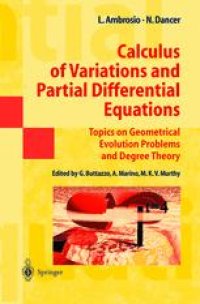
Ebook: Calculus of Variations and Partial Differential Equations: Topics on Geometrical Evolution Problems and Degree Theory
Author: Luigi Ambrosio Norman Dancer (auth.) Giuseppe Buttazzo Antonio Marino M. K. V. Murthy (eds.)
- Tags: Calculus of Variations and Optimal Control, Optimization, Systems Theory Control
- Year: 2000
- Publisher: Springer-Verlag Berlin Heidelberg
- Edition: 1
- Language: English
- pdf
The link between Calculus of Variations and Partial Differential Equations has always been strong, because variational problems produce, via their Euler-Lagrange equation, a differential equation and, conversely, a differential equation can often be studied by variational methods. At the summer school in Pisa in September 1996, Luigi Ambrosio and Norman Dancer each gave a course on a classical topic (the geometric problem of evolution of a surface by mean curvature, and degree theory with applications to pde's resp.), in a self-contained presentation accessible to PhD students, bridging the gap between standard courses and advanced research on these topics. The resulting book is divided accordingly into 2 parts, and nicely illustrates the 2-way interaction of problems and methods. Each of the courses is augmented and complemented by additional short chapters by other authors describing current research problems and results.
The link between Calculus of Variations and Partial Differential Equations has always been strong, because variational problems produce, via their Euler-Lagrange equation, a differential equation and, conversely, a differential equation can often be studied by variational methods. At the summer school in Pisa in September 1996, Luigi Ambrosio and Norman Dancer each gave a course on a classical topic (the geometric problem of evolution of a surface by mean curvature, and degree theory with applications to pde's resp.), in a self-contained presentation accessible to PhD students, bridging the gap between standard courses and advanced research on these topics. The resulting book is divided accordingly into 2 parts, and nicely illustrates the 2-way interaction of problems and methods. Each of the courses is augmented and complemented by additional short chapters by other authors describing current research problems and results.
The link between Calculus of Variations and Partial Differential Equations has always been strong, because variational problems produce, via their Euler-Lagrange equation, a differential equation and, conversely, a differential equation can often be studied by variational methods. At the summer school in Pisa in September 1996, Luigi Ambrosio and Norman Dancer each gave a course on a classical topic (the geometric problem of evolution of a surface by mean curvature, and degree theory with applications to pde's resp.), in a self-contained presentation accessible to PhD students, bridging the gap between standard courses and advanced research on these topics. The resulting book is divided accordingly into 2 parts, and nicely illustrates the 2-way interaction of problems and methods. Each of the courses is augmented and complemented by additional short chapters by other authors describing current research problems and results.
Content:
Front Matter....Pages I-IX
Front Matter....Pages 1-1
Introduction to Part I....Pages 3-4
Geometric evolution problems, distance function and viscosity solutions....Pages 5-93
Variational models for phase transitions, an approach via ?-convergence....Pages 95-114
Some aspects of De Giorgi’s barriers for geometric evolutions....Pages 115-151
Partial Regularity for Minimizers of Free Discontinuity Problems with p-th Growth....Pages 153-169
Free discontinuity problems and their non-local approximation....Pages 171-180
Front Matter....Pages 181-181
Introduction to Part II....Pages 183-184
Degree theory on convex sets and applications to bifurcation....Pages 185-225
Nonlinear elliptic equations involving critical Sobolev exponents....Pages 227-241
On the existence and multiplicity of positive solutions for semilinear mixed and Neumann elliptic problems....Pages 243-258
Solitons and Relativistic Dynamics....Pages 259-283
An algebraic approach to nonstandard analysis....Pages 285-326
Back Matter....Pages 327-347
The link between Calculus of Variations and Partial Differential Equations has always been strong, because variational problems produce, via their Euler-Lagrange equation, a differential equation and, conversely, a differential equation can often be studied by variational methods. At the summer school in Pisa in September 1996, Luigi Ambrosio and Norman Dancer each gave a course on a classical topic (the geometric problem of evolution of a surface by mean curvature, and degree theory with applications to pde's resp.), in a self-contained presentation accessible to PhD students, bridging the gap between standard courses and advanced research on these topics. The resulting book is divided accordingly into 2 parts, and nicely illustrates the 2-way interaction of problems and methods. Each of the courses is augmented and complemented by additional short chapters by other authors describing current research problems and results.
Content:
Front Matter....Pages I-IX
Front Matter....Pages 1-1
Introduction to Part I....Pages 3-4
Geometric evolution problems, distance function and viscosity solutions....Pages 5-93
Variational models for phase transitions, an approach via ?-convergence....Pages 95-114
Some aspects of De Giorgi’s barriers for geometric evolutions....Pages 115-151
Partial Regularity for Minimizers of Free Discontinuity Problems with p-th Growth....Pages 153-169
Free discontinuity problems and their non-local approximation....Pages 171-180
Front Matter....Pages 181-181
Introduction to Part II....Pages 183-184
Degree theory on convex sets and applications to bifurcation....Pages 185-225
Nonlinear elliptic equations involving critical Sobolev exponents....Pages 227-241
On the existence and multiplicity of positive solutions for semilinear mixed and Neumann elliptic problems....Pages 243-258
Solitons and Relativistic Dynamics....Pages 259-283
An algebraic approach to nonstandard analysis....Pages 285-326
Back Matter....Pages 327-347
....